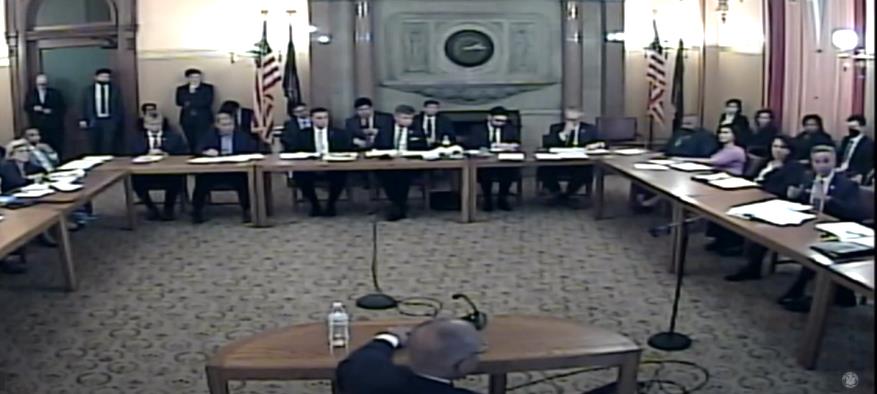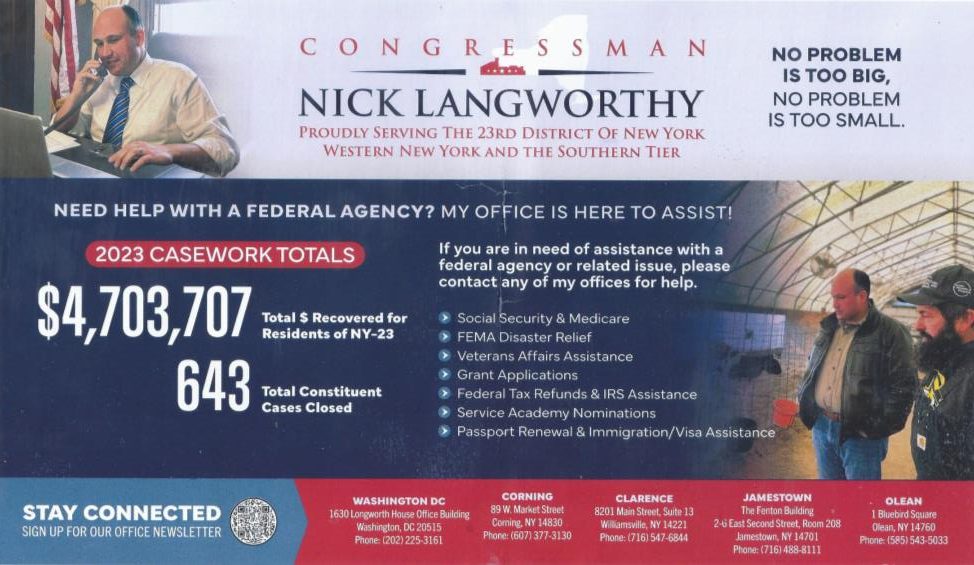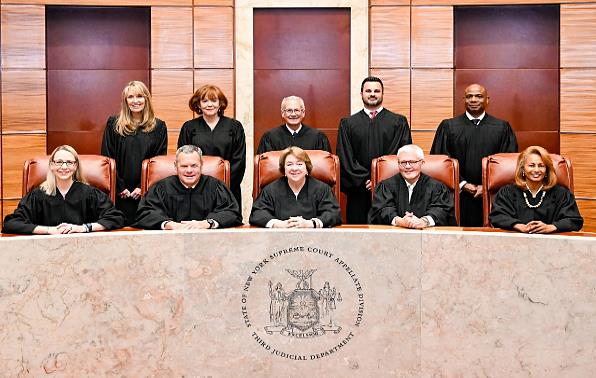Democrats Engineer Revisit to NY Congressional Redistricting

by Robert Lynch, July 29, 2023
If you wonder why State Senate Democrats worked so hard to keep centrist Judge Hector LaSalle off New York’s Court of Appeals last winter and then moved so quickly to elevate, instead, the more liberal Rowan Wilson to become Chief Judge, here’s why.
In a narrow 3-2 ruling, with its majority opinion written by our own Sixth Judicial District’s Judge Elizabeth Garry, a mid-level state appellate court took steps this month that would cast aside the carefully-crafted, court-engineered New York Congressional Districting maps of last year. Judge Garry’s ruling directed an independent commission to go back and redraw those House maps in time for the 2024 elections.
And the Appellate Division, Third Department’s July 13th decision that orders the commission’s revisit could inevitably place redistricting, once again, into the hands of the New York State Legislature, the partisan body whose 2022 Democrat-friendly gerrymander attempt was thwarted only by a Court of Appeals Chief Judge who no longer presides. Chief Judge Janet DiFiore is gone. Rowan Wilson has taken her place. Judge Wilson, with a little help, could tip redistricting’s scales in gerrymander’s favor.
Many of the political and judicial moving parts would need to fall into place just right to make the Democrats’ game plan work. But it could happen. And crafty politicians always strategize.
Moreover, we may very well find ourselves voting in newly-redrawn Congressional districts this next time around. During the past week, Nick Langworthy, the Republican who now serves in Tom Reed’s old Southern Tier district, sent me a campaign mailer. He’s no longer my Congressman. What does Langworthy know that I do not?

“New York Democrats are attempting a blatant partisan power grab thinly disguised as a court case,” Jack Pandol, the National Republican Congressional Committee’s communications director, said in a statement given to The Washington Post and other news outlets shortly after Judge Garry’s decision came down. “Republicans will appeal to protect the will of the voters of New York, and we will fight to hold the line in the Empire State,” Pandol said.
That they have. This past Tuesday, July 25, the Republican intervenors in the Democrat-initiated lawsuit filed a Notice of Appeal to move the redistricting case to the Court of Appeals. Five members of New York’s Independent Redistricting Commission—exactly half its membership—filed notices of appeal as well. The Independent Redistricting Commission (IRC) stands evenly split between Democrats and Republicans.
Any immediate appeal to Judge Wilson’s Court of Appeals would not redraw district lines. It would only decide whether Judge Garry’s slim Third Department majority got it right. The question at hand: Were last year’s Congressional district lines, drawn by a court-appointed special master, good for only one Congressional term, or good for a full decade?
If the Court of Appeals affirms Judge Garry’s determination that the IRC must draw lines for all four future elections of this decade, then the IRC must get to work. And if the Commission deadlocks— like it did last year—then the State Legislature might intervene. And if the Legislature does, then the courts, including Chief Judge Wilson’s Court of Appeals, would likely step in.

And if so, it would be that second Court of Appeals go-around where Judge Wilson’s leadership— and the Court’s new composition—could prove pivotal. After the IRC last year deadlocked, legislative Democrats then drew their own partisan maps. The New York courts then ruled those legislative maps unconstitutional. And on their final review, the Court of Appeals split 4-3 to affirm their unconstitutionality. Chief Judge DiFiore cast the deciding vote to approve the court’s supremacy over the redistricting process.
But Judge DiFiore resigned in August under an ethical cloud. Judge Rowan Wilson, then an associate judge on the Court of Appeals, had written the dissent in that contentious redistricting suit, named Harkenrider v. Hochul. And the wisest observers subsequently speculated that when the State Senate sought to confirm Chief Judge DiFiore’s successor earlier this year that any nominee’s opinions of Harkenrider would bear heavily on legislators’ decision on whether to confirm the judge.
The Senate rejected Governor Hochul’s first nominee, Second Department Judge Hector LaSalle, a perceived moderate, on a near party-line vote. It followed a buzz saw of a hearing, but one in which little was said about redistricting. Hochul’s second choice, Judge Wilson, breezed to approval, gaining overwhelming support from the Senate’s Democratic supermajority. On Harkenrider, of course, Wilson’s stance was a known commodity.

The unanswered question now involves where the Court of Appeals’ newest justice stands. Governor Hochul appointed Caitlin Halligan to succeed Wilson as a Court of Appeals associate. The Senate quickly confirmed her last April. To anyone’s knowledge, she’s never offered an opinion on Harkenrider or on the constitutionality of legislative redistricting. Maybe no one’s ever asked her. And again, as with DiFiore, Halligan’s vote could prove decisive.
Other associates on the Court of Appeals are already on the record. Judges Anthony Cannataro, Madeline Singas, and Michael Garcia had joined Chief Judge DiFiore in holding the legislative redistricting unconstitutional. Judges Jenny Rivera and Shirley Troutman had joined Judge Wilson in dissent.
The current case is Hoffmann v. New York State Independent Redistricting Commission. And to label Judge Elizabeth Garry’s majority opinion as a “Garry-mander” may employ a linguistic twist that’s semantically cute, yet substantively misplaced. The Presiding Justice’s majority opinion for the Appellate Division’s Third Department in its July 13th holding dealt neither with the boundaries of New York’s Congressional districts, nor with the State Legislature’s authority to draw them. Instead, it addressed, narrowly and strictly, the permanence of the district maps that Judge Patrick McAllister had directed a special master to carve out last year once the IRC had deadlocked and the Legislature had strayed beyond the State Constitution. Did the IRC leave work undone, this case asked? Judge Garry’s Third Department majority concluded that it had.
“The IRC had an indisputable duty under the NY Constitution to submit a second set of maps upon the rejection of its first set,” the Presiding Justice wrote. Article III of the State Constitution “makes clear that this duty is mandatory, not discretionary,” Judge Garry continued. “It is undisputed that the IRC failed to perform this duty.”
In the debate surrounding the State Legislature’s 2022 redistricting muddle, our area’s former State Senator, Tom O’Mara, famously stated that the IRC’s bipartisan structure was “pre-ordained to fail.” And likely it was.
Voters in 2014 created the Independent Commission as a constitutionally-mandated vehicle intended to remove politics from redistricting. It didn’t. IRC membership was split equally between the parties. And the system granted state lawmakers limited veto power. Furthermore, legislators passed laws to attempt to give for themselves even more of an upper hand.

At the beginning of last year, the IRC’s evenly-divided partisans produced two sets of Congressional maps. The State Legislature, as the Constitution allowed it, rejected both. The Constitution then called upon the IRC to produce a second set of maps. The IRC refused to do so. That’s when the Legislature—and subsequently the courts— intervened. The courts notwithstanding, Democrats in Hoffmann now argue that the IRC should draft its second-round of maps, admittedly long overdue, and employ them for House elections during the remainder of this decade.
True, those maps were supposed to have been completed in February of last year. But to Judge Garry and the Third Department’s majority, the delay doesn’t matter.
“To hold today that the passing of the deadline leaves petitioners [the Democrats] with no remedy would render meaningless the distinct constitutional command that the IRC create a second set of maps,” Judge Garry wrote. “The right to participate in the democratic process is the most essential right in our system of governance,” she continued. “The procedures governing the redistricting process, all too easily abused by those who would seek to minimize the voters’ voice and entrench themselves in the seats of power, must be guarded as jealously as the right to vote itself….”
Remember, of course, that the Third Department stood closely divided. Just one vote made the difference. In his dissent, Judge Stan Pritzker said he wouldn’t even have chosen to hear the case. He argued the plaintiffs had waited too long to file. He calculated the short, four-month statute of limitations window differently than did the majority.
But on the merits, Judge Pritzker and his dissenting colleague maintained that the time for line-drawing by the IRC has passed, at least for another decade. And he said that Judge DiFiore’s Court of Appeals majority had intended it that way. “[W]e do not believe that, presently, the IRC is duty bound to perform any act until the next census, let alone a ministerial act,” Judge Pritzker wrote.

Gerrymandering is “cheating,” the dissent reminded its opinion’s readers, Pritzker stating that creation of politically-competitive maps was “the raison d’etre [reason for being] behind the 2014 constitutional amendments.”
“It is our view that the judicial remedy cured the IRC’s failure to act by lawfully establishing a redistricting plan for the ordinary duration, leaving no uncured violation of law and thus foreclosing mandamus,” Judge Pritzker wrote. “Although it is not unreasonable for petitioners to wish for a different remedy, this bald desire falls well short of the standard required to mount a successful mandamus proceeding.”
Though the Notices of Appeal filed last Tuesday will prompt a Court of Appeals review of Judge Garry’s Third Department holding, those notices did not explicitly request a stay in Judge Garry’s order. The ambiguity leaves unanswered whether the IRC must—or can—get back to work, or whether a stay in the proceedings should simply be presumed.
John Faso, the former Hudson Valley Congressman and GOP point-person in the redistricting dispute, thinks the newly-filed appeals block further Commission action. Others are not so sure.
“Right now, the commission is under a directive by the Appellate Division to get back to work,” New York Law School professor and redistricting expert Jeffrey Wice told the Queens Daily Eagle. But Wice expects the IRC’s partisan split, and also the September Jewish holidays, to push any Commission map-drawing into October or beyond. Wice also predicts the IRC will hold hearings.
As for the Court of Appeals, its summer recess will delay its review of the case until September.
Still, Democratic petitioners remain eager to move forward. One day before the appeals were filed, the petitioners sent the IRC a letter stating, “Over a week has passed since the Appellate Division’s Opinion and order was entered… Yet the IRC has not made the public aware of any steps it has taken in that time to commence its duties despite the Appellate Division’s instruction that it do so ‘forthwith.’”
“We’re looking forward to getting back to work,” Karen Blatt, the IRC’s Democratic co-executive director, told the New York Post following the appeal’s filing. “And we’re looking forward to working with our Republican side as well.”
Court-drawn congressional redistricting last year took Tompkins County out of the western Southern Tier district of Representative Tom Reed (now Nick Langworthy’s district) and made our county the western anchor of a sprawling new 19th District stretching through Binghamton and on to the Massachusetts border. Republican Marc Molinaro narrowly beat Democrat Josh Riley in last year’s House race in NY-19. Riley’s seeking a rematch in 2024.
On the other hand, had the Democrat-dominated State Legislature’s redistricting map prevailed, Tompkins County’s congressional attention would have been drawn toward Syracuse, and a district whose partisan balance would have been far more favorable to the party of FDR.
But back to where we began: namely with Chief Judge Rowan Wilson; alongside new Court of Appeals colleague Caitlin Halligan. If redistricting- revisited, with its déjà vu process, wanders through a deadlocked IRC, then through a State Legislature bent on gerrymandering, and next on to the courts; what then? Can we expect a different outcome this time? Maybe a ruling consistent with Judge Wilson’s dissenting opinion in Harkenrider last year?
Or maybe not?
During Rowan Wilson’s confirmation hearing for Chief Judge last April 17th, Long Island State Senator Jack Martins asked whether Wilson thought the issue last year in Harkenrider had been decided?
“Yep,” Judge Wilson replied to his Republican questioner. He said it not once, but twice.

“And,” Martins asked, “if a similar case were to come before the court again, would you be inclined to go with the majority opinion that was decided or something else?”
“Similar is kind of a loaded word,” Wilson answered. “But let me answer it this way: It doesn’t matter to me whether a decision is 7-0 or 4-3; it’s a decision of the court, it’s stare decisis. It controls the issues that were raised in that case.”
The Chief Judge nominee went on, giving as an example the “Regina Metropolitan” rent control case. Wilson had dissented in Regina, but applied its majority opinion, contrary to his own, in a later, similar case brought before the Court of Appeals.
“We decided 6-0 it’s controlled by Regina,” Judge Wilson told Senator Martins. “So the fact that I think the Regina decision is wrong, but it’s now the law and I’m bound to follow it.”
Cynics say judges apply precedent, only until they choose not to. So all promises aside, don’t be surprised if Nick Langworthy’s begging for your Enfield vote in November of next year.
###

